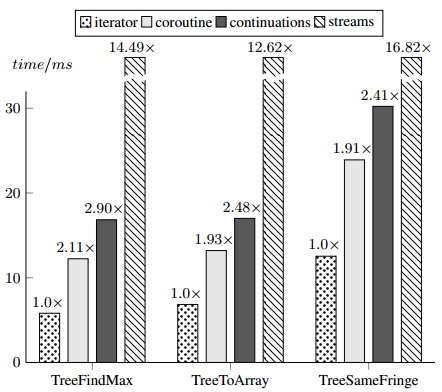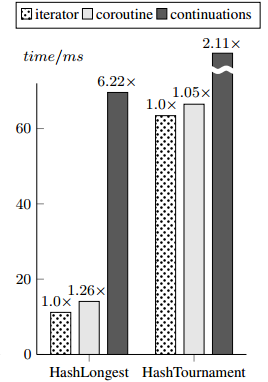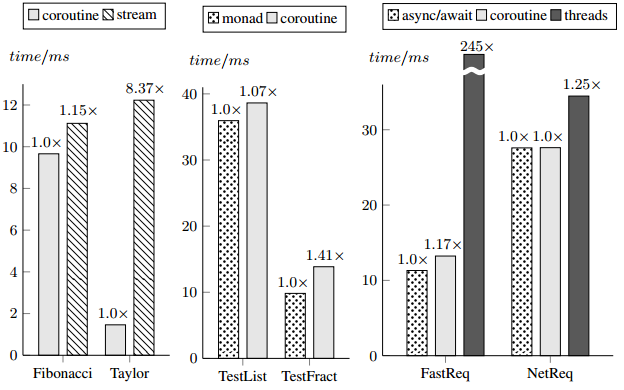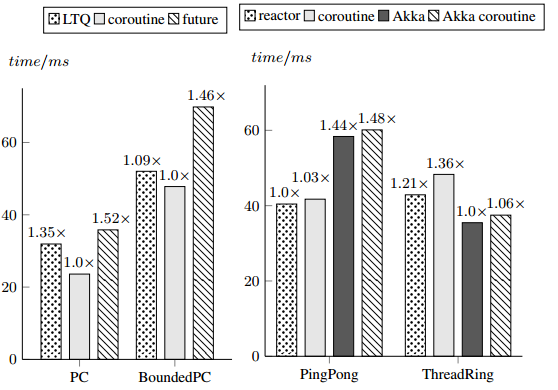Scala Coroutines
First-Class Type-Safe Coroutines in Scala
 Aleksandar Prokopec
/ @alexprokopec
Aleksandar Prokopec
/ @alexprokopec



Behavior trees
A planning model in which an AI agent decides on the next action by traversing a special data structure called a behavior tree.
Every behavior tree is composed of two node types:
task nodes and control nodes.
Task nodes
They are the leaf nodes of a behavior tree.
They execute a side-effect, and return running, success or failure status.
Task nodes
They are the leaf nodes of a behavior tree.
They execute a side-effect, and return running, success or failure status.
Task nodes
They are the leaf nodes of a behavior tree.
They execute a side-effect, and return running, success or failure status.
Control nodes
Control nodes are inner nodes that bind subtrees together.
Given a set of subtrees and their return values, a control node decides whether to run some subtree, or return a success or failure status.
Two basic control nodes: sequence and selector.
Behavior trees can compose
The main reason behind their popularity.
Different subtrees can be developed, tuned and tested independently, and then merged into larger functional units.
Behavior tree extensions
The basic model can be extended with nodes such as
repeaters, randomizers or inverters.
Behavior tree DSLs
<?xml version="1.0" encoding="UTF-8"?>
<agent>
<selector>
<sequence name="capture-the-flag>
<task name="move"></task>
<task name="take-the-flag"></task>
</sequence>
<module name="defend-the-base">
</module>
</selector>
</agent>
Remind you of another tree you know?
Isomorphism
Behavior tree planner is nothing more than an AST interpreter.

Behavior tree downsides
AI researchers have been rediscovering the wheel.
- implementing behavior trees is unintuitive
- nobody likes XML
- essentially an AST interpreter - bad performance
- harder to debug
Why not just use a programming language?
def agent() = {
captureTheFlag() || defendTheBase()
}
def captureTheFlag(): Boolean = {
move() && takeTheFlag()
}
Why not just use a programming language?
def agent() = {
captureTheFlag() || defendTheBase()
}
def captureTheFlag(): Boolean = {
move() && takeTheFlag()
}
Most languages cannot suspend computation and resume it later.
Coroutines - the missing link
A programming construct that allows suspending the computation (i.e. yielding), and resuming it later from the point where it was suspended.
def captureTheFlag(): Boolean = {
yield(move()) && takeTheFlag()
}
Goals of this talk
- Demonstrate how coroutines work in Scala
- Show how Scala coroutines generalize other approaches
Subroutines
val double = (x: Int) => x + x
double(7)
Calling a subroutine
val double = (x: Int) => x + x
double(7)
Calling a subroutine
val double = (x: Int) => 7 + 7
double(7)
Calling a subroutine
val double = (x: Int) => 14
double(7)
Calling a subroutine
val double = ...
14
Calling a subroutine
A function invocation is an entity that exists during program execution.
However, the callsite cannot observe the existence of that entity.
Coroutine definition
val double =
(x: Int) => x + x
Coroutine definition
val double = coroutine {
(x: Int) => x + x
}
This coroutine does not yield.
The yieldval construct suspends computation
and yields a value to the caller.
Coroutine definition
val double = coroutine { (x: Int) =>
yieldval(x)
yieldval(x)
}
Calling a coroutine
Calling a coroutine
Calling a coroutine
Calling a coroutine
Calling a coroutine
Calling a coroutine
Calling a coroutine
Calling a coroutine
Calling a coroutine
Coroutine invocation is resumed by the caller.
Therefore, it is an observable entity in the program.
Calling a coroutine
val double = coroutine { (x: Int) =>
yieldval(x)
yieldval(x)
}
val i = call(double(7))
A coroutine invocation can be observed by the callsite.
Therefore, it must be a first-class object.
Calling a coroutine
val double = coroutine { (x: Int) =>
yieldval(x)
yieldval(x)
}
val i = call(double(7))
var sum = 0
while (i.resume) { sum += i.value }
Calling a coroutine
val double = coroutine { (x: Int) =>
↑yieldval(x)
yieldval(x)
}
val i = call(double(7))↑
var sum = 0
while (i.resume) { sum += i.value }
Calling a coroutine
val double = coroutine { (x: Int) =>
↑yieldval(x)
yieldval(x)
}
val i = call(double(7))
var sum = 0
while (i.resume↑) { sum += i.value }
Calling a coroutine
val double = coroutine { (x: Int) =>
yieldval(x)↑
yieldval(x)
}
val i = call(double(7))
var sum = 0
while (i.resume↑) { sum += i.value }
Calling a coroutine
val double = coroutine { (x: Int) =>
yieldval(x)↑
yieldval(x)
}
val i = call(double(7))
var sum = 0
while (i.resume) { sum += i.value↑ }
Calling a coroutine
val double = coroutine { (x: Int) =>
yieldval(x)↑
yieldval(x)
}
val i = call(double(7))
var sum = 0
while (i.resume↑) { sum += i.value }
Calling a coroutine
val double = coroutine { (x: Int) =>
yieldval(x)
yieldval(x)↑
}
val i = call(double(7))
var sum = 0
while (i.resume↑) { sum += i.value }
Calling a coroutine
val double = coroutine { (x: Int) =>
yieldval(x)
yieldval(x)↑
}
val i = call(double(7))
var sum = 0
while (i.resume) { sum += i.value↑ }
Calling a coroutine
val double = coroutine { (x: Int) =>
yieldval(x)
yieldval(x)↑
}
val i = call(double(7))
var sum = 0
while (i.resume↑) { sum += i.value }
Calling a coroutine
val double = coroutine { (x: Int) =>
yieldval(x)
yieldval(x)
}↑
val i = call(double(7))
var sum = 0
while (i.resume↑) { sum += i.value }
Calling a coroutine
val double = coroutine { (x: Int) =>
yieldval(x)
yieldval(x)
}↑
val i = call(double(7))
var sum = 0
while (i.resume) { sum += i.value }
↑
Coroutine instance operations
call- creates a coroutine instanceresume- resumes a coroutine instancevalue- obtains the last yielded valueresult- obtains the result of the invocation
Typing a coroutine
val double =
coroutine { (x: Int) =>
yieldval(x)
yieldval(x)
}
Typing a coroutine
val double: Int ~> (Int, Unit) =
coroutine { (x: Int) =>
yieldval(x)
yieldval(x)
}
val i: Int <~> Unit =
call(double(7))
Coroutine composition
As coroutine definitions grow larger,
so does the need to decompose them into independent components.
Example: hash table
A closed-addressing hash table is an array containing buckets.
A bucket is a list of elements.
val array: Array[List[T]]
Example: hash table
Assume that we know how to traverse a list of elements.
val bucket =
coroutine { (b: List[T]) =>
var cur = b
while (cur != Nil) {
yieldval(cur.head)
cur = cur.tail
}
}
Example: hash table
Then, we should be able to use that to traverse an array of lists.
val table =
coroutine { (t: Array[List[T]]) =>
var i = 0
while (i < t.length) {
bucket(t(i))
i += 1
}
}
Coroutine composition
Coroutine composition
Coroutine composition
Coroutine composition
Coroutine composition
Coroutine composition
Coroutine composition
The direct call reuses the stack of the same coroutine instance.
Use-cases
How do Scala coroutines generalize other models?
Iterators
def iterator(tree: Tree) =
call(foreach(tree))
val it = tree.iterator
while (it.resume)
println(it.value)
Iterators
Iterators follow directly from foreach definitions.
val foreach =
(t: Tree[T], f: T => Unit) =>
if (t != null)
foreach(t.left, f)
f(t.elem)
foreach(t.right, f)
}
Iterators
Iterators follow directly from foreach definitions.
val foreach =
coroutine { (t: Tree[T]) =>
if (t != null)
foreach(t.left)
yieldval(t.elem)
foreach(t.right)
}
}
Async-Await
def loginRequest(): Future[String]
def httpRequest(c: String): Future[Page]
async {
val credential =
await { loginRequest() }
val ui =
await { httpRequest(credential) }
ui.html
}
Async-Await
How do we define async and await
using coroutines?
Async-Await
def await[R]: Future[R] ~> (Future[R], R) =
coroutine { (f: Future[R]) =>
yieldval(f)
f.value.get.get
}
Async-Await
def async[R](b: () ~> (Future[Any], R)) = {
val i = call(b())
val p = Promise[R]()
@tailrec def loop(): Unit =
if (i.resume)
i.value.onSuccess(loop)
else p.success(i.result)
Future { loop() }
p.future
}
Direct-Style Reactors
An actor must declare all receive operations
in terms of a top-level receive.
class Printer extends Actor {
def receive = {
case x: Int => println(x)
}
}
Direct-Style Reactors
A reactor uses first-class events sources,
and receives by calling onEvent.
class Printer extends Reactor[Int] {
main.events.onEvent { x =>
println(x)
}
}
Direct-Style Reactors
A reactor uses first-class events sources,
and receives by calling onEvent.
class Adder extends Reactor[Int] {
operands.once.onEvent { x =>
operands.once.onEvent { y =>
println(x + y)
}
}
}
Direct-Style Reactors
This soon results in the pyramid of doom.
Instead, we want to write code without nesting.
class Adder extends Reactor[Int] {
val x = operands.get()
val y = operands.get()
println(x + y)
}
Direct-Style Reactors
Challenge: implement methods react and get,
that define a reactor, and extract an event from its event source.
Direct-Style Reactors
type Obs = (() => Unit) => Unit
def get: () ~> (Obs, T) =
coroutine { () =>
var ret: T = _
val obs = (cont: () => Unit) =>
onEvent(x => { ret = x; cont() })
yieldval(obs)
ret
}
Direct-Style Reactors
type Obs = (() => Unit) => Unit
def react[T](c: () ~> (Obs, Unit)) =
Reactor[T] {
val i = call(c())
def loop() =
if (i.resume) i.value(loop)
loop()
}
Simpler ScalaCheck tests
ScalaCheck tests typically used generators to explore the input space.
val tuples: Gen[(Int, Int)] =
for {
a <- choose(0, Int.MaxValue)
b <- choose(0, a)
} yield (a, b)
property("comm") = forAll(tuples) {
a + b == b + a
}
Simpler ScalaCheck tests
More intuitive: backtracking without inversion of control.
property("comm") = {
val a = choose(0 until Int.MaxValue)
val b = choose(0 until a)
a + b == b + a
}
Simpler ScalaCheck tests
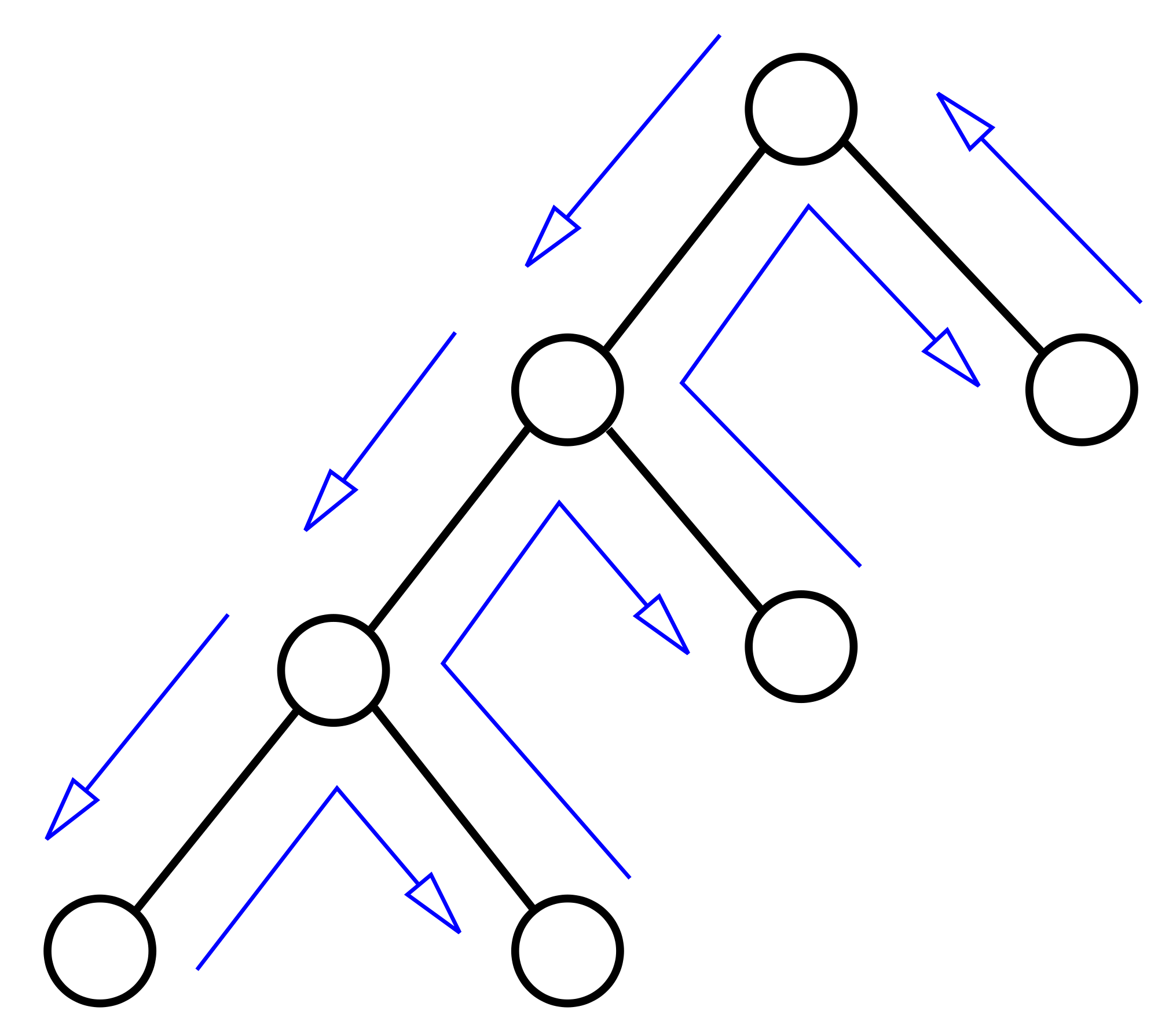
Simpler ScalaCheck tests
type Program = Seq[() => Unit] <~> Unit
val choose:
Seq[Int] ~> (Seq[() => Unit], Int) =
coroutine { (vals: Seq[Int]) =>
var res: Int = _
yieldval(vals.map(x => () => res = x))
res
}
Simpler ScalaCheck tests
type Program = Seq[() => Unit] <~> Unit
val backtrack: Program ~> (Unit, Unit) =
coroutine { (p: Program) =>
if (p.resume) {
for (prepare <- p.value) {
prepare()
backtrack(p.snapshot )
}
} else yieldval(())
}
Simpler ScalaCheck tests
type Test = () ~> (Seq[() => Unit], Unit)
val forever =
coroutine { (test: Test) =>
while (true) {
val p = call(test())
backtrack(p)
}
}
Simpler ScalaCheck tests
def property(t: Test) = {
val i = call(forever(t))
for (i <- 0 until MAX_TESTS) i.resume
}
property {
val a = choose(0 until Int.MaxValue)
val b = choose(0 until Int.MaxValue)
a + b == b + a
}
Equivalence with delimited continuations
type Shift = (() => Unit) => Unit
def reset(b: () ~> (Shift, Unit)) = {
def continue(i: Shift <~> Unit) =
if (i.resume)
i.value(() => continue(i.snapshot))
continue(call(b()))
}
def shift: Shift ~> (Shift, Unit) =
coroutine { (b: Shift) =>
yieldval(b)
}
The most important type alias
type CoroutineAPI =
CallbackStyleAPI => DirectStyleAPI
implicit val aBitOfWork =
implicitly[TwentyLinesOfCode]
Thank you!

http://github.com/storm-enroute/coroutines
